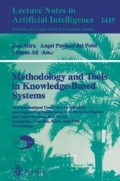Abstract
The goal of Recursion Manipulation (RM) is to design a calculator that provides formal proofs for a particular type of formulae corresponding to the task of program construction and program verification of recursive procedures. Recalling first that Gödel's result cannot be used as a mathematically justifiable argument against RM, the paper illustrates the strategic importance of RM in the design of autonomous, self-reprogrammable robots. In particular, on the basis of more technical papers making a necessary theoretical support for this paper, we illustrate that for roboticians it is sufficient to be concerned with an external characterization of RM. Relying on the Theory of Constructible Domains, the framework of RM is powerful enough to take care of logical justifications inherent to various forms of induction schemes (i.e., the termination justifications for recursive programs and plans). The paper illustrates also that two, not necessarily compatible, types of efficiency are related to recursive plans.
Access this chapter
Tax calculation will be finalised at checkout
Purchases are for personal use only
Preview
Unable to display preview. Download preview PDF.
References
M. Franova: CM-strategy: A Methodology for Inductive Theorem Proving or Constructive Well-Generalized Proofs; in: A. K. Joshi, (ed): Proc. 9th IJCAI; 1985, 1214–1220.
M. Franova: Constructive Matching methodology and automatic plan-construction revisited; Res. Report No.874, L.R.I., Orsay, France, November, 1993.
M. Franova: A Theory of Constructible Domains — a formalization of inductively defined systems of objects for a user-independent automation of inductive theorem proving, Part I; Res. Report No.970, L.R.I., Orsay, France, Mai, 1995.
M. Franova: Definitions Reformulation and Formulation: Why and How? (Saying ‘Good-bye’ to the notion of the well-founded relation); avail. as a report.
M. Franova, M. Kooli: Recursion Manipulation for Robotics: Why and How?; to appear in proc. of EMCSR'98.
J. Giesel: Termination Analysis for Functional Programs using Term Orderings; Proc. of SAS'95, LNCS 983, 1995, 154–171.
G. Huet: Induction Principles formalized in the Calculus of Constructions; Programming of Future Generation Computers, Elsevier, 1988, 205–216.
K. Kunen: A Ramsey Theorem in Boyer-Moore Logic; Journal of Automated Reasoning, 1995, Vol.15, No.2, 217–235.
Z. Manna, R. Waldinger: How to Clear a Block: A Theory of Plans; Journal of Automated Reasoning 3, 1987, 343–377.
D. McAllester, K. Arkoudas: Walther recursion; in: LNAI 1104, 1996, 643–657.
C. Paulin-Mohring: Inductive Definitions in the system Coq Rules and Properties; in: LNCS 664, Springer-Verlag, 1993, 328–345.
L. C. Paulson: Set Theory for Verification; J. of Aut. Reasoning Vol. 15, No.2, 1995, 167–215.
L. C. Paulson: A fixedpoint approach to implementing (co)inductive definitions; in: LNAI 814, Springer-Verlag, 1994, 148–161.
A. M. Pitts: A co-induction principle for recursively defined domains; Theoretical Computer Science, vol. 124, No. 2, 1994, 195–219.
R. Reiter: Proving Properties of States in the Situaton Calculus; Artificial Intelligence 64, 1993, 337–351.
O. Stepankova, I.M. Havel: A Logical Theory of Robot Problem Solving; Artificial Intelligence 7, 1976, 129–161.
P. Taylor: Intuitionistic Sets and ordinals; Journal of Symb. Logic, Vol. 61, No. 3, Sept, 1996, 705–744.
C. Walther: On Proving the Termination of Algorithms by Machine; Artificial Intelligence, vol. 71, no. 1, 1994, 101–159.
Author information
Authors and Affiliations
Editor information
Rights and permissions
Copyright information
© 1998 Springer-Verlag
About this paper
Cite this paper
Fraňová, M., Kooli, M. (1998). Theory of constructible domains for robotics: Why?. In: Mira, J., del Pobil, A.P., Ali, M. (eds) Methodology and Tools in Knowledge-Based Systems. IEA/AIE 1998. Lecture Notes in Computer Science, vol 1415. Springer, Berlin, Heidelberg. https://doi.org/10.1007/3-540-64582-9_734
Download citation
DOI: https://doi.org/10.1007/3-540-64582-9_734
Published:
Publisher Name: Springer, Berlin, Heidelberg
Print ISBN: 978-3-540-64582-5
Online ISBN: 978-3-540-69348-2
eBook Packages: Springer Book Archive

